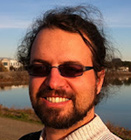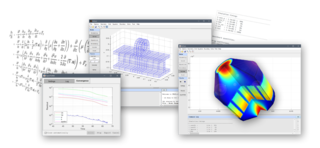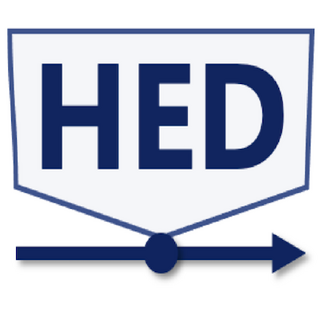
MATLAB is a proprietary multi-paradigm programming language and numeric computing environment developed by MathWorks. MATLAB allows matrix manipulations, plotting of functions and data, implementation of algorithms, creation of user interfaces, and interfacing with programs written in other languages.
Source separation, blind signal separation (BSS) or blind source separation, is the separation of a set of source signals from a set of mixed signals, without the aid of information about the source signals or the mixing process. It is most commonly applied in digital signal processing and involves the analysis of mixtures of signals; the objective is to recover the original component signals from a mixture signal. The classical example of a source separation problem is the cocktail party problem, where a number of people are talking simultaneously in a room, and a listener is trying to follow one of the discussions. The human brain can handle this sort of auditory source separation problem, but it is a difficult problem in digital signal processing.
In signal processing, independent component analysis (ICA) is a computational method for separating a multivariate signal into additive subcomponents. This is done by assuming that at most one subcomponent is Gaussian and that the subcomponents are statistically independent from each other. ICA was invented by Jeanny Hérault and Christian Jutten in 1985. ICA is a special case of blind source separation. A common example application of ICA is the "cocktail party problem" of listening in on one person's speech in a noisy room.

An event-related potential (ERP) is the measured brain response that is the direct result of a specific sensory, cognitive, or motor event. More formally, it is any stereotyped electrophysiological response to a stimulus. The study of the brain in this way provides a noninvasive means of evaluating brain functioning.
Chronux is an open-source software package developed for the loading, visualization and analysis of a variety of modalities / formats of neurobiological time series data. Usage of this tool enables neuroscientists to perform a variety of analysis on multichannel electrophysiological data such as LFP, EEG, MEG, Neuronal spike times and also on spatiotemporal data such as FMRI and dynamic optical imaging data. The software consists of a set of MATLAB routines interfaced with C libraries that can be used to perform the tasks that constitute a typical study of neurobiological data. These include local regression and smoothing, spike sorting and spectral analysis - including multitaper spectral analysis, a powerful nonparametric method to estimate power spectrum. The package also includes some GUIs for time series visualization and analysis. Chronux is GNU GPL v2 licensed.

20-sim is a commercial modeling and simulation program for multi-domain dynamic systems, which is developed by Controllab. With 20-sim, models can be entered as equations, block diagrams, bond graphs and physical components. 20-sim is used for modeling complex multi-domain systems and for the development of control systems.
Quantitative electroencephalography is a field concerned with the numerical analysis of electroencephalography (EEG) data and associated behavioral correlates.

Arnaud Delorme is a university professor at Paul Sabatier University in Toulouse, an adjunct faculty member at the Swartz Center for Computational Neuroscience at University of California, San Diego, a consulting research scientist at the Institute of Noetic Sciences. At UCSD, Dr. Delorme contributed to development of the widely used Matlab toolbox for electroencephalography (EEG) analysis, EEGLAB. He has been acknowledged for his contribution to the field of EEG research by being awarded a Bettencourt-Schueller young investigator award in 2002 and one of three of the ANT EEG Company 10-year Anniversary Young Researcher Awards in 2006. His research has focused on pure neuroscience methods, as well as on the neuroscience of mind wandering, meditation, and so-called mediums.
FieldTrip is a MATLAB software toolbox for magnetoencephalography (MEG) and electroencephalography (EEG) analysis. It is developed at the Donders Institute for Brain, Cognition and Behaviour at the Radboud University Nijmegen, together with collaborating institutes. The development of FieldTrip is supported by funding from the BrainGain, Human Connectome and ChildBrain projects. The FieldTrip software is released as open source under the GNU General Public License.
The Neurophysiological Biomarker Toolbox (NBT) is an open source MATLAB toolbox for the computation and integration of neurophysiological biomarkers. The NBT toolbox has so far been used in seven peer-reviewed research articles, and has a broad user base of more than 1000 users. The NBT toolbox provides unique features for analysis of resting-state EEG or MEG recordings. NBT offers a pipeline from data storage to statistics including artifact rejection, signal visualization, biomarker computation, statistical testing, and biomarker databasing. NBT allows for easy implementation of new biomarkers, and incorporates an online wiki that aims at facilitating collaboration among NBT users including extensive help and tutorials. The standardised way of data storage and analysis that NBT proposes allow different research projects to merge, compare, or share their data and biomarker algorithms.
Psychophysics Toolbox Version 3 (PTB-3) is a collection of free functions for MATLAB or GNU Octave intended for use by neuroscience and vision researchers. It synthesizes and shows accurately controlled visual and auditory stimuli and interacts with the observer. It has at least twelve thousand active users, an active forum, and many citations. PTB-3 is based on the Psychophysics Toolbox Version 2 (PTB-2) but its MATLAB extensions were rewritten to be more modular and use OpenGL. Psychtoolbox is offered alongside many alternative toolboxes for programming Psychophysics and Psychology experiments, such as PsychoPy for Python or jsPsych for JavaScript.
Corticocortical coherence is referred to the synchrony in the neural activity of different cortical brain areas. The neural activities are picked up by electrophysiological recordings from the brain. It is a method to study the brain's neural communication and function at rest or during functional tasks.

FEATool Multiphysics is a physics, finite element analysis (FEA), and partial differential equation (PDE) simulation toolbox. FEATool Multiphysics features the ability to model fully coupled heat transfer, fluid dynamics, chemical engineering, structural mechanics, fluid-structure interaction (FSI), electromagnetics, as well as user-defined and custom PDE problems in 1D, 2D (axisymmetry), or 3D, all within a graphical user interface (GUI) or optionally as script files. FEATool has been employed and used in academic research, teaching, and industrial engineering simulation contexts.
Fractal physiology refers to the study of physiological systems using complexity science methods, such as chaos measure, entropy, and fractal dimensions. The underlying assumption is that biological systems are complex and exhibit non-linear patterns of activity, and that characterizing that complexity is useful to understand, and make inferences and predictions about the system.
MNE-Python ("MNE") is an open source toolbox for EEG and MEG signal processing. It is written in Python and is available from the PyPI package repository.
NeuroKit ("nk") is an open source toolbox for physiological signal processing. The most recent version, NeuroKit2, is written in Python and is available from the PyPI package repository. As of June 2022, the software was used in 94 scientific publications. NeuroKit2 is presented as one of the most popular and contributor-friendly open-source software for neurophysiology based on the number of downloads, the number of contributors, and other GitHub metricsa.

Hierarchical Event Descriptors (HED) is a conceptual and software framework that includes a family of controlled vocabularies for annotating experimental metadata and experienced events on the timeline of neuroimaging and behavioral experiments. The goal of HED is to standardize annotations and the mechanisms for handling these annotations to enable searching, comparing, and extracting data of interest for analysis. HED is the event annotation mechanism used by the Brain Imaging Data Structure (BIDS) standard for describing events.





